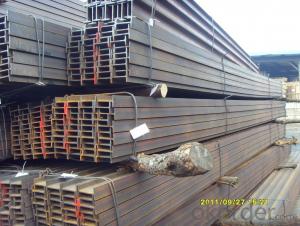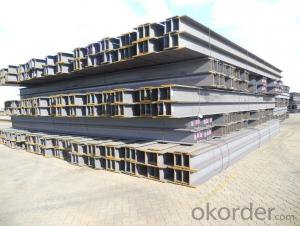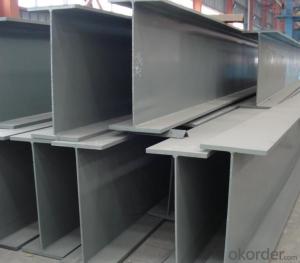H beams/Ibeams GB standard/JIS standard EN standard
- Loading Port:
- Tianjin
- Payment Terms:
- TT OR LC
- Min Order Qty:
- 100 m.t.
- Supply Capability:
- 3000 m.t./month
OKorder Service Pledge
OKorder Financial Service
You Might Also Like
Packaging & Delivery
Packaging Detail:packed in bundle, suitable for sea transport (by container) or According to the clients`requirements
Delivery Detail:According to the actual weight
Specifications
joist steel
high quality and factory price
large inventories
short delievery time
good after-sales service
Country of Origin: China
Mill name: Ningbo Preah Vihear Steel Industry Co., Ltd.
Commodity: H beam
Tolerance: Strictly according to the G/B and JIS standard
Delivery time: within 30days
Price term: CIF/ CFR according to clients requirements
Payment terms: 100%Irrevercable L/C At Sight or TT
Product Description
ACCORDING TO STANDARD: JIS G3192 OR GB/T11263-2005
H beam Section sizenma(mm)Weight (kg/m)
Height×BreadthWeb thichnessFlange thichness
100×1006816.9
125×1256.5923.6
150×15071031.1
175×1757.51140.4
200×20081249.9
250×25091471.8
300×300101593.0
300×3001515105.0
350×3501219134.9
400×4001321171.7
148×1006920.7
194×1506929.9
244×17571143.6
294×20081255.8
340×25091478.1
390×3001016104.6
440×3001118120.8
482×3001115110.8
488×3001118124.9
582×3001217132.8
588×3001220147.0
100×50579.3
125×606813.1
150×755714.0
175×905818.0
198×994.5717.8
200×1005.5820.9
248×1245825.1
250×1256929.0
298×1495.5832.0
300×1506.5936.7
346×1746941.2
350×17571149.4
396×19971156.1
400×20081365.4
446×19981265.1
450×20091474.9
496×19991477.9
500×200101688.1
596×199101592.4
600×2001117103.4
700×3001324181.8
800×3001426206.8
900×3001628240.1
- Q:Are steel H-beams suitable for mezzanine flooring?
- Yes, steel H-beams are commonly used for mezzanine flooring due to their strength, durability, and load-bearing capacity. Mezzanine floors are typically installed in industrial or commercial settings to create additional usable space within a building. Steel H-beams provide excellent structural support and can withstand heavy loads, making them suitable for supporting the weight of the mezzanine flooring and any equipment or materials that will be placed on it. Additionally, steel H-beams can be easily customized to accommodate specific design requirements and can be seamlessly integrated with other structural elements of the mezzanine system. Overall, steel H-beams are a reliable and practical choice for mezzanine flooring.
- Q:Are steel H-beams suitable for use in the construction of hospitality resorts or hotels?
- Indeed, steel H-beams prove to be a fitting choice for the construction of hospitality resorts or hotels. They possess various advantages that render them the preferred option within the hospitality industry. First and foremost, steel H-beams exhibit remarkable strength and durability, enabling them to bear heavy loads and provide structural stability. This quality proves to be crucial for extensive construction endeavors like hospitality resorts or hotels, which often necessitate multiple floors, expansive areas, and the ability to withstand potential natural disasters such as earthquakes or hurricanes. Furthermore, steel H-beams possess a lightweight nature when compared to other construction materials such as concrete or timber. This characteristic facilitates easier transportation and handling during the construction process. Consequently, this leads to cost savings and accelerated construction timelines, both of which are vital factors in delivering hospitality projects punctually and within budget. Additionally, steel H-beams grant architects and engineers design flexibility, empowering them to create innovative and aesthetically pleasing structures. They can be utilized to craft grand, open atriums, spacious ballrooms, and other distinctive architectural features commonly found in hospitality resorts or hotels. Another notable advantage of steel H-beams is their resistance to fire, pests, and rot. This ensures the long-lasting durability and safety of the structure, thereby reducing maintenance and repair costs over time. Lastly, steel H-beams exhibit environmental friendliness as they are typically fashioned from recycled materials and can be recycled once again at the conclusion of their life cycle. This aligns with the growing trend of sustainable and eco-friendly construction practices within the hospitality industry. To conclude, steel H-beams prove to be highly suitable for the construction of hospitality resorts or hotels due to their strength, durability, design flexibility, fire resistance, and environmental benefits. They provide a reliable and efficient solution for constructing large-scale projects within the hospitality sector, thereby ensuring the safety, comfort, and satisfaction of guests.
- Q:What are the different methods of joining Steel H-Beams together?
- There are several different methods available for joining steel H-beams together, depending on the specific requirements and circumstances of the project. Some of the most common methods include welding, bolting, and riveting. 1. Welding: Welding is perhaps the most popular and widely used method for joining steel H-beams together. It involves melting the adjacent surfaces of the beams and then allowing them to cool and solidify, effectively fusing them together. Welding can be done using various techniques such as arc welding, gas welding, or laser welding, depending on the thickness and type of steel being used. 2. Bolting: Bolting is another common method for joining steel H-beams. It involves using bolts and nuts to secure the beams together. This method is often preferred when there is a need for disassembling or reassembling the structure. Bolting provides a strong and reliable connection and allows for easy adjustment or replacement of beams if needed. 3. Riveting: Riveting is a traditional method that involves using metal rivets to join steel H-beams together. It requires drilling holes in the flanges of the beams and then inserting and securing the rivets through the holes. Riveting provides a strong and durable connection, but it can be time-consuming and requires skilled labor. 4. Adhesive bonding: Adhesive bonding is a less commonly used method for joining steel H-beams together. It involves using high-strength adhesives to bond the surfaces of the beams. This method is often used in applications where welding or bolting may not be feasible or desirable, such as in certain architectural or aesthetic projects. 5. Hybrid methods: In some cases, a combination of different joining methods may be used to achieve the desired connection strength and structural integrity. For example, welding can be combined with bolting to provide additional reinforcement and stability. It is important to note that the choice of joining method depends on factors such as the load-bearing requirements, structural design, accessibility, and the skills and equipment available. Consulting with a structural engineer or a professional in the field is recommended to determine the most suitable method for a specific project.
- Q:Are steel H-beams suitable for rooftop structures?
- Yes, steel H-beams are suitable for rooftop structures. Steel H-beams are known for their strength and durability, making them an ideal choice for supporting heavy loads on rooftops. They are capable of withstanding the weight of various rooftop structures such as solar panels, HVAC systems, and equipment. Steel H-beams provide excellent structural support, ensuring the stability and safety of the rooftop structure. Additionally, steel H-beams are resistant to corrosion and have a longer lifespan compared to other materials, making them a reliable choice for rooftop applications.
- Q:Can Steel H-Beams be used in convention center or exhibition hall construction?
- Certainly! Convention centers and exhibition halls can make use of Steel H-Beams in their construction. The construction industry frequently relies on Steel H-Beams due to their robustness and longevity. These beams offer essential support and stability to substantial edifices, rendering them perfect for convention centers and exhibition halls that often necessitate expansive interiors and lofty ceilings. Steel H-Beams possess the ability to endure substantial loads and can be effortlessly manufactured and installed, making them a favored option in constructing such establishments. Furthermore, the adaptability of steel permits architects and engineers to fashion distinctive and visually captivating structures.
- Q:Are steel H-beams suitable for buildings with heavy machinery or equipment?
- Steel H-beams are an excellent choice for buildings that house heavy machinery or equipment due to their exceptional strength and durability. These beams are specifically designed to withstand heavy loads and provide reliable support. The unique shape of the H-beam, with its flanges and web, ensures excellent structural integrity and allows for superior distribution of weight. Moreover, steel is renowned for its high tensile strength and resistance to deformation, making it a dependable option for heavy-duty applications. As a result, steel H-beams offer a stable foundation for buildings requiring the accommodation of heavy machinery or equipment, guaranteeing the overall construction's structural stability and safety.
- Q:Are steel H-beams suitable for industrial structures?
- Industrial structures can benefit greatly from the use of steel H-beams. These beams, also known as I-beams or universal beams, are specifically designed to handle heavy loads and provide structural stability. Their unique shape, featuring a wider flange and narrower web, allows for even weight distribution and resistance against bending or twisting forces. Steel H-beams possess several advantages that make them an ideal choice for industrial structures. Firstly, they have a high strength-to-weight ratio, meaning they can support heavy loads while remaining relatively lightweight. This not only makes them cost-effective but also easier to handle during the construction process. Additionally, steel is a durable material that can withstand harsh environmental conditions and resist corrosion, ensuring the longevity and safety of the structure. Another advantage of steel H-beams is their versatility. They can be easily fabricated to different lengths and sizes, providing flexible design options and accommodating various construction requirements. Furthermore, these beams can be joined together either by bolting or welding, allowing for the creation of larger structural components. This makes them suitable for constructing wide-span industrial buildings or supporting heavy machinery and equipment. Moreover, steel H-beams offer excellent structural integrity and stability. Their shape provides resistance against bending and torsion, making them capable of withstanding dynamic loads and seismic forces. This makes them particularly well-suited for industrial structures that are exposed to heavy machinery operations, vibrations, or potential impacts. To summarize, steel H-beams are highly suitable for industrial structures due to their strength, durability, versatility, and stability. They possess efficient load-bearing capabilities, enabling the construction of strong and reliable industrial buildings that can withstand heavy loads and harsh environmental conditions.
- Q:What does H steel.R represent?
- The latest H steel specifications range wide, medium and narrow flange H steel size, H- height, B- width, t1- web thickness, t2- flange thickness, r- rounded radius
- Q:What is the cost of steel H-beams?
- The cost of steel H-beams can vary depending on various factors such as the size, grade, and supplier. It is recommended to contact local steel suppliers or check online marketplaces for accurate and up-to-date prices.
- Q:Can steel H-beams be used in school gymnasium or sports facility construction?
- School gymnasiums or sports facilities can indeed utilize steel H-beams in their construction. These beams are widely employed in the building industry because of their robustness, endurance, and adaptability. They offer exceptional support and structural integrity, which makes them particularly well-suited for expansive areas such as gymnasiums and sports facilities. The H-shaped design of these beams enables them to bear heavier loads, making them an ideal option for structures that require substantial weight support. Moreover, steel H-beams are resistant to the effects of weathering, corrosion, and fire, guaranteeing the safety and durability of the construction. In summary, steel H-beams are a dependable and effective choice for constructing school gymnasiums or sports facilities.
1. Manufacturer Overview |
|
|---|---|
| Location | |
| Year Established | |
| Annual Output Value | |
| Main Markets | |
| Company Certifications | |
2. Manufacturer Certificates |
|
|---|---|
| a) Certification Name | |
| Range | |
| Reference | |
| Validity Period | |
3. Manufacturer Capability |
|
|---|---|
| a)Trade Capacity | |
| Nearest Port | |
| Export Percentage | |
| No.of Employees in Trade Department | |
| Language Spoken: | |
| b)Factory Information | |
| Factory Size: | |
| No. of Production Lines | |
| Contract Manufacturing | |
| Product Price Range | |
Send your message to us
H beams/Ibeams GB standard/JIS standard EN standard
- Loading Port:
- Tianjin
- Payment Terms:
- TT OR LC
- Min Order Qty:
- 100 m.t.
- Supply Capability:
- 3000 m.t./month
OKorder Service Pledge
OKorder Financial Service
Similar products
New products
Hot products
Related keywords



























